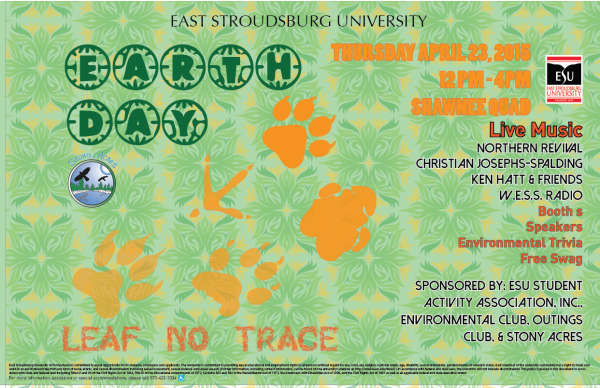

Photo Courtesy / Eric Kump
By Lian Mlodzienski
News Editor
Leaf no trace this year and help East Stroudsburg University celebrate Earth Day! The event will take place on April 23 on the Shawnee Quad from 12:00 PM until 4:00 PM. It is free and open to the public.
There will be booths, environmental trivia, and free giveaways among other activities throughout the day. Live music will be provided by Northern Revival, Christian JosephsSpalding, Kenneth Hatt & Friends, and W.E.S.S. Radio.
Megan Wilson and two representatives from the Monroe County Conservation District will speak at the event. Topics will include the decline of monarch butterflies and Monroe County Species of Concern.
Casey Cruz, the head of the Earth Day Committee at ESU, said, “To be actively involved with ESU’s annual Earth Day event has been a great experience! The environment and its current ecological and political issues have always been close to my heart.”
She continued, “Our planet and its health, in this current day in age, is commonly a privilege that is overlooked and not prioritized by many in our society. This is why being a part of organizing an event, to raise awareness to the student’s on campus about the threatening realities we collectively are facing, was so important to me.”
Earth Day, officially April 22, began in 1970 during what many think of as the hippie and “flower child” culture.
While many protested the war in Vietnam, the environment was not viewed as a pressing issue.
It wasn’t until 1962, when Rachel Carson’s “Silent Springs” became a “New York Times” bestseller, that the environment was more than a spelling bee word. After selling half of a million copies in 24 countries, the public had taken the idea of saving the environment mainstream.
The idea for Earth Day was sparked by the destructive oil spill of 1969 in Santa Barbara, California. Then U.S. Senator from Wisconsin, founder of Earth Day, Gaylord Nelson, saw an opportunity to push environmental protection to the forefront of the national agenda.
With the help of then Congressman Pete McCloskey and recruit Denis Hayes, Nelson launched a “national teach-in on the environment.”
This resulted in 20 million Americans learning about a healthy, sustainable environment. Organizations that had previously been protesting oil spills and pollution now banded together for a common goal.
At the time, the environmental movement brought both Republicans and Democrats of a variety of backgrounds together.
The first Earth Day led to the creation of the U.S. Environmental Protection Agency, Clean Air Clean Water Act, and Endangered Species Act (ESA). According to earthday.org, Nelson later said, “It was a gamble, but it worked.”
By the 1990’s, Earth Day went global with about 200 million people and 141 countries getting involved. That year, the cause to which many were dedicated was recycling efforts.
Cruz commented, “Earth Day to me is an educational celebration where our community can gain further appreciation, respect, and insight for all that the Earth provides for us to coexist and thrive as a species!”
This year, at ESU, the theme for Earth Day is saving endangered species. According to the National Wildlife Foundation, as of 2009, there are 1,361 plants and animals in the United States that are threatened or endangered.
If they are endangered, they are likely to become extinct throughout all or most of their range. If they are threatened, the species is likely to become endangered in the near future. In addition to these, there is the designation of a critical habitat, which means that the habitat is vital for the survival of the species.
The U.S. Fish and Wildlife Service oversees the listing and protection of all terrestrial and freshwater species. The National Marine Fisheries Service oversees all marine life. These groups determine whether different species require special protection.
A species may be deemed eligible for protection if a large percentage of the species’ habitat is damaged or destroyed, it suffers over-consumption by commercial, recreational, scientific, or educational uses, it’s threatened due to disease or predation, there is inadequate protection of the species due to current regulations or legislations,
or the long-term survival of the species is at jeopardy.
After becoming a listed species, that plant or animal receives special protections by the federal government. This can mean a new law outlawing the hunting, wounding, or shooting of an animal.
There can also be a federal permit issued on private land to protect the property on which a plant resides.
Cruz stated, “I hope this year’s theme of endangered species will help open the eyes of our students to … the effects that our collective actions have on our global ecosystems!”
For more information about the ESU Earth Day event, email Casey Cruz at ccruz@live.esu.edu.
Email lian at:
lmlodzien1@live.esu.edu
